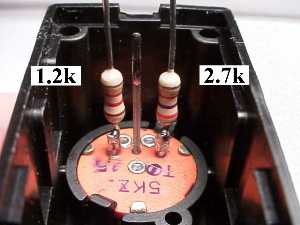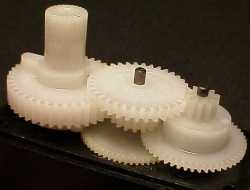How to Modify a Futaba S-148
for 180 Degree Operation
Text and Photos by:
Dave McDonald
AMA 40128
(dmcdnld@yhti.net)
Did you ever need a servo that rotated 180 degrees to
run a cheap pair of mechanical retracts? And did you cringe at the thought of
spending twice as much money just for that retract servo.....than you paid for your
retracts themselves?
Or........
Did you ever wish you had a fully proportional servo
that rotated 180 degrees to operate your flaps?......but you couldn't find one
anywhere......at any price?
UPDATE:
I think I owe Airtronics an apology here! It has been brought to my attention that
the Airtronics 94739 is a 170 degree proportional double ball bearing servo that is
similar in size to the Futaba S-148, but with nearly twice the torque.
The Airtronics 94739 servo lists for about 100 dollars with a street price of about 70
dollars.
Thank you Jack Albrecht for bringing this to my attention!
This procedure will explain how to easily modify a
standard Futaba S-148 into a servo that travels 180 degrees instead of the usual 60
degrees. But unlike a dedicated retract servo, this modified S-148 will still be
fully proportional.
Modifying the electronic circuit only requires adding 2
new resistors to the
S-148 circuitry. It isn't diffiult to do.....BUT......because of the
very limited space inside the S-148 servo, and the small size of the S-148 circuit board,
I don't recommend that you try this unless you are experienced at soldering and
desoldering small electronic circuits.
And now that the disclaimer is out of the way,
here's how I did it: :-)
Materials needed:
You'll only need a total of 2 new resistors for this
project.
One is a 1.2k resistor, 1/4 watt. (brown, red, red)
The other is a 2.7k resistor, 1/4 watt. (red, violet, red)
Disassembling the Futaba S-148 Servo:
- Remove the servo arm and hold down screw.
- Remove the (4) bottom case screws, and the bottom case cover.
- Remove the top section of servo case.
- Remove all of the servo gears from the middle section of the servo case.
- Remove both of the small screws holding the motor to the servo case
middle section.

- De-solder the three feedback pots leads from the circuit board.
(See photo on left) Be sure all three leads are COMPLETELY de-soldered before going
to the next step! (Note: Solder wick works best!)
- Carefully push both the motor and the circuit board out of the middle
servo case section, leaving the feedback pot in it's original position.
- Before removing the feedback pot from the middle case, place a mark of
some sort on the pot and the case that will help to identify the correct orientation later
during the reassembly process.
- Carefully remove the feedback pot from the middle servo case section.
Modifying the Futaba S-148 Servo
for 180 Degree Rotation:
- Locate the two outer leads of the feedback potentiometer, and leaving
about 1/4 inch of the leads sticking out of the bottom of the feedback pot, cut off the
excess leads. (Note: Do NOT cut the center lead!)
- Double check the circuit board to make sure that the three holes in the
circuit board are left fully open. De-solder again if necessary. (Note:
Solder wick works best!)
- Prepare both new resistors by trimming ONE of the leads off of each
resistor down to about 1/4 inch in length. Leave the other lead of each resistor
full length.
- Pre-tin the shortened resistor leads on both resistors.
- Pre-tin both of the shortened outer feedback pot leads.

- Refer to the photo on the left for the next four steps.
- Orient the feedback pot into a similar position as the photo, so you are
looking directly at the lead side of it, and the leads sticking out of the pot appear to
be in the eleven, twelve, and one o'clock positions.
- Referring to the photo, solder the 1/4 inch lead of the 1.2k resistor to
the 1/4 inch lead of the feedback pot that is in the Eleven O'Clock position. (Note:
The end of the short resistor lead should be up against the base of the pot before
soldering.)
- Again referring to the photo, solder the 1/4 inch lead of the 2.7k
resistor to the 1/4 inch lead of the feedback pot that is in the One O'Clock position. (Note:
The end of the short resistor lead should be up against the base of the pot before
soldering.)
- Re-install the feedback pot into the middle servo case section, using
the photo shown above, and your mark that you made earlier, to insure correct alignment.
- Carefully place the motor/circuit board assembly back into the middle
section of the servo case by threading the two resistor leads through the two outer holes,
and the center pot lead back into the center hole. Push on the motor and circuit
board until they are fully seated back into the proper position.
- Re-install the two motor hold down screws.
- Solder the 1.2k resistor lead, the 2.7k resistor lead, and the center
lead of the feedback pot to the circuit board, and trim off the excess leads. (Note:
Do NOT use too much solder here, or the excess solder could run down inside of the servo,
possibly causing a short circuit!)

- Re-install the entire servo geartrain back into the middle section of
the servo case. Be sure the output gear is installed correctly before proceeding to
the next step. (Note: With the feedback pot shaft in the middle position of
it's rotation, install the output gear in the position shown. If it's on backwards,
the molded "tab" on the output gear won't let the top/middle gear fit
correctly.)
- Place the case top section back into the proper position.
- Place the case bottom section back into the proper position.
- Re-install the 4 screws that hold the servo together.
Do NOT allow the modified servo to try
to rotate beyond the mechanical limits of the geartrain!!!
If necessary, adjust your transmitter's
ATV to avoid over driving the servo!!!
Please let me know how your 180 degree modification
project worked out!
Just click on one of these links and
Send your comments to:
Thanks
Dave!
My
180 Degree Futaba S-148 Works Perfectly!
or
Dave,
I've Got a Problem with My 180 Degree S-148!
or
Dave,
you S.O.B.!!!!
You
Made Me Ruin a Perfectly Good S-148!
NOTICE:
Although I'm granting free access to view this web page at
no charge, the text and photos within this article may NOT be reproduced, nor may they be
used for profit without the expressed written permission of the author, Dave McDonald.
Comments?
E-Mail me at:
dmcdnld@yhti.net
(Back To Dave
McD's ULTRA SPORT 40 ARF)
(Back to R/C
Air Force)
(Home)